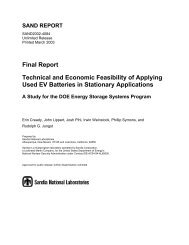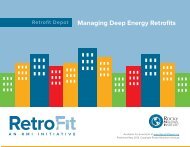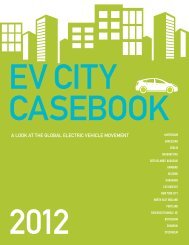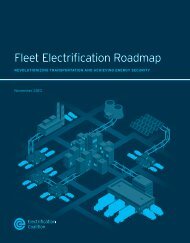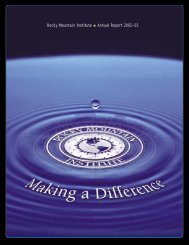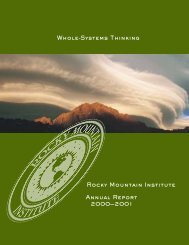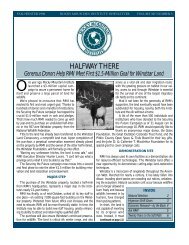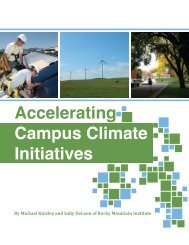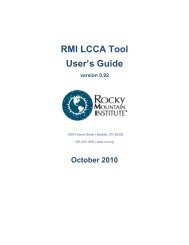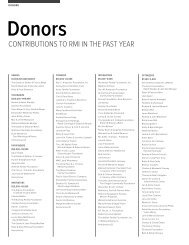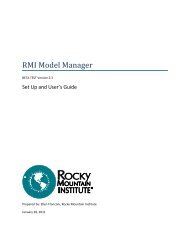Institutional Acupuncture Institutional Acupuncture - Rocky Mountain ...
Institutional Acupuncture Institutional Acupuncture - Rocky Mountain ...
Institutional Acupuncture Institutional Acupuncture - Rocky Mountain ...
- No tags were found...
Create successful ePaper yourself
Turn your PDF publications into a flip-book with our unique Google optimized e-Paper software.
RMI Annual Report 2009 – 2010roughly tripled efficiency. To help vault barriers, like sparse objective assessments of a myriad newfuel-saving techniques, RMI drew corporate partners into a nonprofit spinoff—the North AmericanCouncil on Freight Efficiency (p. 22)—seeking strong efficiency for competitive advantage. Thishelped build industry receptiveness to the first U.S. efficiency standards for heavy trucks, which EPApublished in October 2010.Our collaborations with key industrial partners are frequent, diverse, and effective. Previous AnnualReports have described joint efforts ranging from iconic, like the Empire State Building retrofit(p. 14), to little-known or proprietary, like many mining, chemical, real-estate, and automotiveprojects. RMI has for decades helped leading hydrocarbon and electric-utility firms face strategicchallenges, because as Bill Tolbert said, “If you’re not part of the problem, you can’t be part of thesolution.” Hence our collaboration with the nation’s number three producer of coal-fired electricity,Duke Energy (p. 20), and soon with others.Some technical projects demonstrate big savings but reveal even bigger icebergs of hiddenopportunity. For example, a U.K. data center we codesigned, which EDS (now HP) built in 2009at normal cost, saved 73 percent of non-IT energy and 98 percent of cooling and pumping energy,tripled computing per watt, and quadrupled potential capacity. Yet EDS reckoned adopting all ourrecommendations could have saved about 95 percent of energy and 50 percent of capital cost—tempting us to test that hypothesis next.Such breakthroughs have a way of pushing industry to a new level. Often the highest hurdle is thefirst—finding the right receptive partner at a ripe instant. Our chance to shift chip fabs’ efficiencyfollowed more than a decade of failures to slip through the invisible crack between industry upturns(when everyone is too busy to think about novel design) and downturns (when such rethinking isdeferred until it’ll be needed). Texas Instruments’ Paul Westbrook finally achieved that feat. Our 2003collaboration saved $230 million of capital cost as well as much energy, water, and up to a thousandhigh-tech American jobs. TI’s farsighted choice to share its learnings with competitors—it blessedApplied Materials’ sending me to describe them at China’s big chipmaking conference—has raisedthat sector’s global efficiency bar.Even in that excellent project, some big efficiency opportunities couldn’t be tested in time for thedesign deadline, but intrigued another firm galvanized by TI’s breakthrough. That company’s nextfab should save about two-thirds of the energy and half the capital cost. Now we’re starting toenvisage 8–10-fold energy savings at even lower cost. The master key is rapid mutual learning withhighly motivated expert partners. This creates hands-on implementation experience, teachablecases, competitive pressure for emulation, and revenue to leverage the philanthropy that funds ourinnovation. Adam Kahane quotes an African proverb: “If you want to walk fast, walk alone. If youwant to walk far, walk together.” Through business collaborations, RMI does both.5
<strong>Institutional</strong> <strong>Acupuncture</strong>our upcoming “RetroFit Depot,” a comprehensive online resource about why, when, and how to dodeep energy-efficiency retrofits.Further, RMI’s RetroFit effort aims to understand and tackle other barriers throughout the deep-retrofit“ecosystem” that includes building owners, energy service companies (ESCOs), utilities, financiers,appraisers, code officials, and more, plus the architects, engineers, and contractors implementingretrofits. We engaged an external research organization to interview a sample of stakeholders so wecould better understand their needs. This process confirmed, for example, that building owners needtools to analyze and verify paybacks—so early in 2011, such tools will be available for download.On another front, our Next Generation Utility team (p. 19) is accelerating two necessary but difficultand complex shifts of the electricity system: from fossil fuels to efficiency and renewables, and fromcentralized to distributed architectures. To mobilize many diverse players and help them overcomebarriers, our NGU team is driving deeper engagement along many dimensions. While continuingour strategic collaborations with leading electric utilities, we also work with regulators, investors,analysts, research laboratories, and entrepreneurs. Noted thought leaders in these sectors advise ourresearch work, and we are collaborating with key organizations to increase the relevance, focus, andeffectiveness of our work.This focus on wide-scale engagement and transformation has also shifted our business model. In pastyears, consulting fees typically provided more than half our revenue. But a dramatic increase in yourphilanthropic support has enabled us to intensify our focus on writing, thought leadership, convening,teaching, and online tool development—thereby making our collaborative partnerships morediscriminating, valuable, and effective.As we increase our level of engagement with target sectors and deepen our practice as “institutionalacupuncturists,” the world is becoming more and more receptive to our collaboration. Industryleaders want to understand how to create a cleaner, safer, smarter world. The massive outwardchanges we intend to drive are requiring inward change at RMI. Your support makes both kinds ofchange possible, and we are grateful to be on this exciting path with you.Michael Potts, President and CEO8
RMI Annual Report 2009 – 2010Letter from the Lead Independent TrusteeMany events in the past year have caused me to reflect on RMI’s key role in the harder-than-ever-expected transition the U.S.is making to a more vibrant, efficient, and benign energy future. Several years ago, RMI leadership and Trustees agreed tostrengthen the Institute’s organizational and financial foundations and focus on a limited set of crucially important topic areas.The letters from Amory Lovins and Michael Potts reflect our thoughts on implementation of these directions. Amory has longtalked of the necessity for “institutional acupuncture” with systems both human and physical. In this case we are applyingacupuncture techniques to improve the flow of qì (“chi”) energy among ourselves and our many partners.We are very excited about Reinventing Fire, which follows the lead of our path-breaking Winning the Oil Endgame of 2004and broadens the focus to showing how we can free ourselves from the need for other fossil fuels as well. Once again, we arefocusing on applying the RMI trademark whole-system thinking to help the nation move more efficiently to a better future. Oilspills and mine disasters punctuate the human and ecological urgency of this effort. But the inconstancy of media attentionto such disasters stands in stark contrast to RMI’s consistent and persistent focus on these issues. Amory Lovins and our otherleaders have been analyzing, writing, and speaking out on energy efficiency, the role of renewables, and the imperative ofthoughtful and expeditious change for decades—regardless of fluctuations in energy prices, public policy positions of the partiesin power, or vagaries of public opinion. This constancy is supported by the generosity of our much-appreciated donors, whohave raised the level of gift support to RMI to a new record in FY2010. We thank you!One of the unique features of RMI over the years has been our determination to test our ideas in the marketplace, makingsure that our thinking maintains close contact with the realities experienced by those who are confronted with the doing ofenergy efficiency. Thus, as a “think-and-do tank” we have long lived with the tension of contracting with corporations for realconceptual and design work, on the one hand, and a being more publication-oriented research shop on the other. In this pastyear we have been experimenting with a new model of greater partnership and collaboration in our initiatives, working withcorporate, government, and other nonprofit entities, emphasizing the quality and impact of our joint efforts. These initiatives arecarefully devised, planned, scheduled, and undertaken to match both the sectoral impact we can have (e.g., solar PV) and to pairour in-house resources with those we must draw on. We have established a “Programmatic Review and Evaluation Panel” (PREP)to vet every RMI initiative and ensure the effort is both game-changing and practicable. Only after this diverse team of in-houseexperts has scrutinized every aspect does an initiative progress to implementation. The rigor required by this process can be seenin the enhanced focus of the projects described in this annual report. The Trustees of RMI are proud and grateful to be a part—along with our National Solutions Council members, the Legacy Society, generous philanthropists, and our collaborators andpartner organizations—in this crucial and exciting work.Suzanne H. Woolsey, Lead Trustee9
Human beings are born [because of] theaccumulation of qì [“chi” or “vital force”].When it accumulates there is life. When itdissipates there is death...There is one qì that connects and pervadeseverything in the world.Zhuangzi (Chuang Tzu) (ca. 4th Century BCE)True mastery can be gainedby letting things go their own way.It can’t be gained by interfering.Laozi (Lao Tzu) (6th Century BCE),Daodejing (Tao Te Ching) 48
RMI Annual Report 2009 – 2010RMI’s Reinventing Fire Initiatives: What and WhyIn July 2010 RMI celebrated the results of its year-long strategy development by choosing its firstfive initiatives. Two initiatives have a multi-sector focus. One is, of course, the capstone ReinventingFire effort to develop, roll out, and aggressively market a 40-year plan to migrate the United Statesoff fossil fuels smoothly, securely, and profitably—so business is motivated to do the heavy lifting.Another is our old friend 10xE (Factor Ten Engineering, p. 26), reborn with a twin focus on bothacademic and practitioner environments to provide methodologies and processes for our majorindustrial projects and work in all other sectors.Two additional initiatives center on building owners and service industries. RetroFit (p. 13) focuseson how and when to deeply retrofit existing commercial buildings, while our Superefficient HousingInitiative (p. 16) will accelerate superefficiency (more than 60 percent better than today’s averagenew build) into housing built at scale, including affordable housing and modular housing. Thefinal initiative, Next Generation Utility (NGU, p. 19), will speed change in the electricity sectorby working with industry leaders seeking low- or no-carbon operation and increased security,reliability, and resilience.Each initiative will run for three years or more and is approved, guided, and monitored by RMI’snew senior leadership steering group, the PREP (p. 9). Each is designed around a detailed theoryof change—what needs to happen, who needs to take action, how, and in what order—withcheckpoints, feedback, and continuous learning. Each initiative also requires extensive resources,typically costing from one to several million dollars per year. Most initiatives will involve all RMI’scapabilities—research, collaborative work, design, convening, writing and speaking, communicationsand outreach, fundraising, leadership, and management. We expect each initiative to have asignificant impact, but there are no easy wins here; each initiative is a considerable challenge. But atRMI we don’t run away from big problems—we run toward them.RMI Initiatives:• Reinventing Fire• RetroFit• Next Generation Utility• Superefficient Housing• Factor Ten EngineeringBesides these five initiatives, we continue to work on three more modest but still important andfamiliar projects. Project Get Ready (PGR, p. 25), an RMI-funded effort to improve and acceleratethe adoption of electric cars and their supporting infrastructure, will continue, and we are exploringpartnerships with organizations that can contribute insights and expand PGR’s impact. The NorthAmerican Council for Freight Efficiency (NACFE, p. 22), which we helped incubate, already hasnearly 300 members. And RMI recently executed our solar “Balance of System” project (p. 17), whichincluded a successful industry charrette on redesigning everything except the module in order toreduce cost in large-scale photovoltaic (PV) plants—the processes, system-level concepts, and in somecases even the physical design and materials. In addition, RMI continues several long-term effortsimportant to our mission, such as military energy efficiency (p. 27) and micropower analysis (p. 21).11
<strong>Institutional</strong> <strong>Acupuncture</strong>RMI also plans to convene in 2011 a group of expert building modelers and major energy-simulationsoftware developers to brainstorm features that would help the industry better represent energy-savingfeatures and promote the technical and financial benefits to their clients.“To achieve widespread adoption of whole-system retrofits, the industry needs competent energy andfinancial analysis,” said Kendra Tupper, an RMI senior consultant. “In the short term, RMI is addressingthe barriers to this by developing and disseminating training and educational materials and creatingtools and templates that will save time and increase the quality of energy modeling. RMI will alsoconvene currently fragmented industry stakeholders and practitioners to develop a coordinated longtermvision and workplan for the industry.”Kendra Tupper, PE, RMI senior consultantThe energy-modeling tools and training materials will be available on RetroFit Depot, RMI’s onlineresource for deep retrofits. RetroFit Depot will offer case-studies, financial and energy tools, and data.There, a property owner will find the business case for doing deep retrofits while a service providerwill find supporting technical data, such as energy survey checklists and lifecycle-cost analyses. Lookfor RetroFit Depot in early 2011 at www.retrofitdepot.org.Empire State Building Project UpdateThe flagship Empire State Building project is well along in implementation, with the most importantstep—remanufacturing its 6,514 windows onsite into superwindows—completed in September2010. Cutting winter heat loss by at least two-thirds and summer heat gain by half, the advancedglazings, along with improved lights and office equipment, will cut the building’s peak coolingload by one-third. The old chillers can then be renovated and reduced rather than replaced andexpanded—saving more than $17 million of capital cost that helps pay for the other savings and thuscuts the payback time to three years. The expected 38 percent energy saving is several times thenorm for a building of this kind.The Empire State Building project nicely illustrates the power of the deep retrofits that RMI’s RetroFitinitiative aims to make standard. It also illustrates how we choose partners: an owner, Tony Malkin,who is eager to share his experience; an energy service company, Johnson Controls, seekingmomentum in deep retrofits and able to put competitive pressure on other ESCOs; and a propertymanager, Jones Lang Lasalle, that could similarly shift its business model, influencing not only thebillions of square feet it manages but also the space its rivals manage.14
RMI Annual Report 2009 – 2010Making Markets Super: Shopping for Energy BargainsThe United States has more than 85,000 grocery stores, each with the floorspace of a large officebuilding but using twice the energy. In the past year, RMI worked with several supermarket chainsto develop innovative ways to save energy, reduce waste, and increase revenues. Supermarkets havesuch razor-thin profit margins that energy efficiency is vital to their survival. For some supermarketchains, store energy, water and waste costs amount to less than one percent of gross sales but canequate to nearly one-third of profits.In a typical supermarket, refrigeration uses about 36 percent and space conditioning about 28 percentof electrical use. RMI’s experts recently showed one chain how to save nearly 50 percent of its energyconsumption, in large part by upgrading space-conditioning and refrigeration equipment, reducing airinfiltration, and adding desiccant dehumidification.Lighting is another big energy user, but simple and often low-cost measures such as skylights, LEDcase lighting, dimming controls, and light-colored surfaces can save almost half of a store’s lightingenergy while improving merchandising.A charrette led by RMI produced a 38% more energyefficientnew prototype store for Stop & Shop in Foxboro,Mass. Shown here is the daylighting/electric lighting designby the late leader of RMI’s building practice, Greg Franta,FAIA, and RMI Senior Fellow Nancy Clanton, PE.Stores also use a lot of water. To save over half, the RMI and client team proposed water-frugalrestroom fixtures and kitchen equipment, removing ice from seafood cases, xeriscaping with nativelandscaping (which can often eliminate the need for irrigation), capturing rainwater and condensate,and reclaiming carwash water for reuse.“Turning ‘waste’ at a grocery store into valuable recyclables and compost can be a profit center forstores by avoiding tipping fees while reaping recycling revenues,” said RMI Principal Alexis Karolides,AIA. “The gold standard is ‘zero’ waste, defined as at least 90 percent reduction in landfill waste.”This work, like most efficiency efforts, goes on behind the scenes, away from customers. But aconventional store’s extensive signage and advertising give grocery chains an opportunity to craft amessage that’s attractive to customers while influencing the entire industry.“Chains have a golden opportunity to highlight the efficiency measures they are undertaking, whichhelps them keep costs and prices low,” Karolides said. “Some green building measures, such asdaylighting, have been linked to improved shopping experience and sales. And customers maytake away more than groceries from their shopping experience. They may gain energy- and waterefficiencyideas they can apply at home—so they’ll have more money to spend on, say, groceries.”15
<strong>Institutional</strong> <strong>Acupuncture</strong>RMI’s Superefficient Housing Initiative: Getting New Homes onthe Right TrackWhat if our homes could be 60 to 80 percent more efficient, healthier, and more comfortable thancontemporary homes, yet equally or more affordable? Today, that’s feasible, but energy- and dollarefficienthomes remain uncommon. Why?This question is central to RMI’s soon-to-launch Superefficient Housing Initiative. Over the past year,an RMI team dug into the production-home industry to explore how affordable residences can bebuilt to use 60 to 80 percent less energy than current building codes require, even without renewableenergy sources.“Most people aren’taware that in newand existing homes,integrated, efficientdesign and retrofitstrategies candramatically reducefossil fuel use, canimprove comfort andhealth, and need notbreak the bank.”“Most people aren’t aware that in new and existing homes, integrated, efficient design and retrofitstrategies can dramatically reduce fossil fuel use, can improve comfort and health, and need not breakthe bank,” said RMI Principal Alexis Karolides, AIA. “People may associate ‘green’ with expensive PVpanels, but it is much more cost-effective to optimize your home’s efficiency first, before consideringrenewables. Though there are good examples of superefficient homes, there are many impediments inthe marketplace that have kept such homes from going mainstream. This is what we will address.”RMI plans to achieve scale by seeding superefficiency into the business strategies of key builders’nationwide portfolios, and by spreading best practices through regional and city-to-city peernetworking structures.“If we know that the country’s top 20 builders build one-third of America’s homes, we havea good idea of where to start,” said RMI Principal James Brew, AIA, an expert on Japaneseprecision-built-home techniques and a certified Passivhaus Design Consultant. “If we can changeone or two of the large production builders, it will have a profound effect on the others as theysee themselves fall behind in the increasingly competitive housing market. It is a great opportunityto achieve significant impact broadly and quickly.”RMI’s Superefficient Housing Initiative evolved differently than the rest and represents a newarena for RMI, which until now focused on commercial buildings. The idea emerged fromhundreds of meetings and interviews with professionals from every corner of the industry.Institute researchers identified a need, a new hypothesis, and a distinctive set of barriers that theindustry needs to overcome.16
<strong>Institutional</strong> <strong>Acupuncture</strong>In June 2010, <strong>Rocky</strong> <strong>Mountain</strong> Institute convened more than 50 industry stakeholders and expertsfor a design charrette. The charrette offered this fragmented, fast-moving, and multifaceted industry aforum for collaborative innovation on cutting installed BoS costs for commercial and utility-scale roofandground-mounted PV systems. The charrette’s findings, at rmi.org/BOSreport, underscore how asystemic approach, leveraging synergies across boundaries, can yield major savings.Charrette participants found ways to reduce BoS costs to $0.60–0.90 per peak watt—45 to 65percent below current best practice—via highly efficient structural designs, new electrical systemarchitectures, better site information, and increased standardization of physical designs and processesto enable high-volume manufacturing and speed project development. Coupled with cheapermodules, these recommendations could make solar energy match or beat retail electricity in mostU.S. markets. Industry “coopetition”—cooperation for mutual benefit in a competitive environment—is essential for identifying and removing barriers.A key workshop finding is that major BoS cost reductions are not contingent on a single breakthroughtechnology: existing approaches offer high potential for cost reduction but significant challengesremain. Each PV system is unique, must be individually designed, and is regulated by one of nearly30,000 local jurisdictions.Doug Payne, SolarTech cofounder and executive directorBusiness process costs, from proposal to interconnection, are a particularly thorny issue. Since thecharrette, RMI has worked with California-based SolarTech, a national consortium dedicated toeliminating barriers to PV market growth, to streamline BoS processes and reduce associated costand risk. Cofounder and Executive Director Doug Payne, who attended the charrette, said it helpedSolarTech reframe the issue strategically. The bottom line, he said, is figuring out how to drive downthe costs incurred from process delays and eliminate inefficiencies. “We need to attack this onmultiple fronts, in many new ways, with as much innovative thinking as possible,” he said.The charrette also helped SolarTech wrap a long-planned set of best practices into the broaderframework of a “National Solar Exchange.” These practices provide developer expertise and criticalinformation about viable sites that make markets more efficient.RMI’s BoS charrette report suggests a number of industry activities across physical design, businessprocesses, and industry scale to help support BoS cost-reduction goals. RMI is collaboratingwith SolarTech, the U.S. Department of Energy, and other stakeholders, including PV developersand manufacturers, to increase understanding and awareness of cost-reduction opportunities.Among other tasks, RMI is undertaking deeper analysis of business process costs—which varysubstantially by project size, location, ownership, and project phase—to help align industry-wideincentives for cost reduction.18
RMI Annual Report 2009 – 2010Several weeks after the San Jose charrette, Energy Secretary Dr. Steven Chu kicked off the DOE’s“$1/W Workshop” (attended by RMI’s Dr. Stephen Doig). The assembled experts lauded thecharrette’s findings, which reach encouraging conclusions about the feasibility of a game-changinggoal—an installed PV system cost low enough to beat the cost of all new central power stations. RMIis confident that this work will contribute to significant near-term BoS cost reductions.RMI’s Next Generation Utility (NGU) Initiative: RethinkingElectricity Demand, Supply Architecture, and Industry StrategyIn the past few years, the utility sector has evolved tremendously. As climate, economic, and securitychallenges have grown, and as the regulatory world has shifted, utilities have reexamined their roles.Today, simply serving the customer isn’t enough—how is just as important. Efficiency and renewablesare now commonplace in utility parlance, and some firms are delving deeply into unfamiliar areasranging from biomass to combined-heat-and-power.Throughout its history, RMI has been active in the electricity sector—the most complex, vital,and capital-intensive sector of the economy. In 2009, this effort entered its next phase, the NextGeneration Utility (NGU) initiative, to pursue and apply advanced concepts in collaboration withforward-thinking utilities.NGU has four threads: creating a techno-economic vision of a fossil-fuel-free electric system;identifying key enablers to make that vision a reality; designing tools to support insightful decisionmaking;and collaborating with electric utilities to overcome barriers. In the process, NGU is rollingout some fascinating ideas.Lena Hansen, RMI principal and utility expertPerhaps NGU’s most thought-provoking notion of late, according to RMI principal and utility expertLena Hansen, turns the notion of electric demand and supply on its head (see www.rmi.org/rmi/Transforming+Electric+Utilities).“The traditional attitude has been that we have this inflexible demand, so to meet it we need supplysideresources—power plants—that are flexible and that can be turned on and off whenever we like,”Hansen explained. “Now we have to flip that equation and consider the supply—wind and solar—inflexible while considering demand flexible. That means smart grids, electric vehicles, efficiency,demand response, load-shifting, and other options that can together choreograph all resources to19
<strong>Institutional</strong> <strong>Acupuncture</strong>meet customers’ service needs reliably and at least cost.”In other words, the power sources previously thought negligible because “the sun doesn’t alwaysshine and the wind doesn’t always blow” are now relevant because modern digital technologiescan act as a time and demand broker, matching whatever supply is available (and cheap, clean, andreliable) with whatever needs society has. “It’s a very different way of thinking,” Hansen said. “It’s avery different way of operating the system.”Energy modeling and analysis are essential to identifying and addressing barriers and solutions, buteffectiveness requires adoption by industry. Fortunately, RMI is partnering with the respected andengineering-savvy firm Duke Energy to explore the next generation utility model. A few years back,Duke Energy created Vision 2030—an aspirational look at how the company could cut its carbonemissions 50 percent by 2030.Based on the results of that work, Duke Energy engaged RMI to “help our thinking about whatthe future might hold so we could look more broadly at the actions we could take to prepare for acarbon-constrained future,” according to Janice Hager, Duke Energy’s vice president of IntegratedResource Planning and Regulated Analytics. “I felt like RMI really brought to the table reasonablealternative views of how the future could play out. We looked at a lot of things that RMI did—wereally dug into it. I walked away with the perspective that while I might not draw the same conclusion,they had drawn reasonable conclusions. A key example was how much wind you can integrate into asystem. As a system operator, that’s something we as a utility think hard about, and we tend to believethere is a pretty low limit on how much wind we can have on the system and still feel comfortablethat we can operate it. I walked away believing it may be possible to accommodate more wind onour system than I thought going into our discussions. They helped me broaden my thinking on a lot offactors that impact resource plans.”From the partnership with Duke, RMI’s team also gained a deeper understanding of the real barriersutilities face in moving towards a fossil-fuel-free electric system. “Partnering with utilities is a criticallyimportant part of our work,” Hansen said. “We believe that the most effective way to maximizeour mission impact is to constantly balance our cutting-edge research with the reality of running abusiness so that we can create practical solutions.”In the next year, the extensive new findings emerging from the NGU team’s Reinventing Fire researchwill inform new collaborations with leading utilities and policymakers.20
RMI Annual Report 2009 – 2010RMI’s Micropower DatabaseWorld electricity production is at last shifting dramatically toward a goal RMI has advanced fordecades: diverse, dispersed, renewable sources that make money, cut risk, and boost resilience.RMI is the independent clearinghouse for data on the global growth of what The Economist calls“micropower”: cogeneration (a.k.a. combined-heat-and-power) plus all renewable electricitygenerators except big hydroelectric dams. Our detailed, transparent, documented database’s May2010 update (www.rmi.org/rmi/RenewablesMicropowerTransformingElectricityLandscape) revealedthat in 2008, micropower provided ~91 percent of the world’s new electricity. Thanks to lower costsand financial risks, and despite generally lower subsidies, it’s walloping new coal, nuclear, and gasfiredpower plants.Micropower remains little-noticed because its economies come from mass production, not giantunits; many official databases still omit its small and often privately owned units of capacity. Yetduring 2000–09, its share of global electricity production rose from 13 to 18 percent while nuclearpower’s fell from 17 to 13 percent. The U.S. added more windpower capacity in 2007 than it addedcoal-fired capacity in 2003–07. Europe in 2009 closed more coal and nuclear capacity than it added;71 percent of its capacity additions were renewable.Globally, windpower and solar photovoltaics (PVs) are growing so explosively (see graph) thatGlobal Generating Capacity:nuclear generation’s output growth fell behind PVs’ in 2007 and will probably never catch up. AfterAnnual Net Additions, 1990–2010a decade averaging 60 percent annual growth, grid-connected solar power is entering takeoff into50low price and high volume (see p. 17). The end of 2011 will probably see global PV-making capacityaround 35 billion watts (GW) per year. The PVs made by those factories every seven years (a typicalreactor’s construction time) could produce more annual electricity than the 59 billion watts of40reactors being built worldwide.China, now number one in five renewable technologies, just blew past its 2020 windpower target. In302006, China’s distributed renewables had nearly seven times its nuclear capacity and were growingseven times faster; by 2009, this gap had widened, and China had halved its net rate of coal-powerGWadditions in just three years. Nearly three-eighths of its net 20 capacity additions planned for 2010 arerenewable—encouraging news, since China and India burn nearly half the world’s coal and planthree-fourths of the world’s new coal-fired power plants.GW2010In 2009, renewables were one-fourth of global power capacity, half of new capacity, and overhalf of new power-plant investment. Renewables except big hydro will surpass nuclear power inglobal capacity in 2010 and in output around 2014–15 0 (micropower did so in 2001 and 2005). In1990 1995 2000 2005 2010504030100-10Global Generating Capacity:Annual Net Additions, 1990–20101990 1995 2000 2005 2010WindPhotovoltaicsNuclearAggressive Solar ForecastWindPhotoNucleAggre-1021
<strong>Institutional</strong> <strong>Acupuncture</strong>2009, renewables except big hydro got $131 billion of private investment and added 52 billionwatts. Nuclear plants got no private investment, losing capacity for the second and output forthe third year running.In the U.S., new reactors are over 100 percent subsidized, but still can’t raise private capital, becausethey have no business case. Of the 60 reactors under construction worldwide as of 10 September2010, 12 have been so listed for over 20 years, 42 have no official startup date, half are late, 44 are infour untransparent and centrally-planned power systems (China, India, Russia, South Korea), and all60 were bought by central planners.“Innovative fleetsand suppliers seethe opportunity andurgency that exists forus to improve freightefficiency not only tohelp our industry bemore successful, butto get ahead of futureregulations aroundfuel consumption.”Reinventing Fire (p. 11) will reinforce RMI’s decades of integrative thinking (including a 21 January2010 Foreign Policy article, www.rmi.org/rmi/Library/2010-02_ProliferationOilClimatePattern)showing how the market-driven shift to micropower can stem the spread of nuclear weapons, protectthe climate (micropower saves far more carbon, far faster, than nuclear could), make electricitysupplies more reliable and resilient, and boost global development. Not bad for investments that getlittle respect and much derision but are already quietly winning in the marketplace.NACFE: A Comprehensive Search For ImprovementsFor years, heavy trucks have been synonymous with inefficiency. Class-8 trucks use about 2.4 millionbarrels of oil a day, or one-eighth of all the oil used in the U.S. Trucks’ greenhouse-gas emissionshave risen more than 50 percent since 1990. And while other modes of ground transportation havemade strides, the trucking industry is slower to adapt. Despite potential for dramatic gains in trucks’fuel economy, recent innovation has been incremental, especially as the recession shriveled truckers’budgets and many struggled for mere survival.The North American Council for Freight Efficiency (NACFE), formed by RMI in 2009, isfocused on improving heavy trucks’ fuel efficiency and putting a big dent in the transportationsector’s carbon emissions.A lack of trusted and credible sources of efficiency technology performance, and a shortage of businesscasedata, make investment in fuel efficiency seem risky. NACFE was established to address that problemby assessing and distributing performance information from testing agencies and laboratories, collectingmarketing and user data, and providing accessible, up-to-date efficiency information.22
RMI Annual Report 2009 – 2010“The independent and credible aspect of the Council gives it a huge opportunity for success,” saidMichael Roeth, NACFE executive director, a 25-year industry veteran from Navistar. “Most decisionsto procure products are based only on information from the suppliers who have a commercial andfinancial stake in the process. The third-party character of the NACFE is a crucial need of the industryand a direct success factor for the Council.”Since forming, NACFE has named a Board of Directors and a Technical Advisory Committee, andelected Roeth as executive director. NACFE’s initial projects will be announced in fall 2010 atNACFE’s second “Driving Innovation” meeting in Dearborn, Michigan. “This meeting will providethe entire trucking marketplace a chance to become personally involved in the development andadoption of cost-cutting, environmentally beneficial technologies and services,” Roeth said. “Anyonefrom fleet owners who are frustrated with fluctuating fuel prices to technology providers andindustry suppliers looking to bring efficiency solutions to market will have the opportunity to join amembership organization dedicated to addressing these challenges.”Michael Roeth, NACFE executive directorSo far, almost 300 industry leaders have joined NACFE, and their numbers continue to grow.According to Roeth, engagement is key. “Innovative fleets and suppliers see the opportunity andurgency that exists for us to improve freight efficiency not only to help our industry be moresuccessful but to get ahead of future regulations around fuel consumption.” he said. “Now they havean engaged community to help them do so.”Bright Automotive: Driving for a Brilliant FutureFor an example of where RMI’s “rubber meets the road,” look no further than BrightAutomotive—RMI’s third formal for-profit spinoff and second automotive spinoff.Each year, government and business buy or lease hundreds of thousands of fleet vehicles. Thesefleet vehicles are only 7 percent of all light-duty vehicles sold, but they use 20 percent of their fuelbecause fleet vehicles are driven hard and fleet vans average less than 15 mpg.Bright started with the IDEA—a lightweight, aerodynamic, electrified fleet van that gets about100 mpg. It cuts fuel use by about three- to twelve-fold, depending on the driving cycle. Yetunlike other plug-in hybrids, the IDEA requires no subsidy to make a strong business case to thefleet buyer. That’s because it eliminated most of the costly batteries through “platform fitness”—designing out unnecessary weight, drag, and rolling resistance, so far less energy is needed tomove the vehicle.23
<strong>Institutional</strong> <strong>Acupuncture</strong>In April 2009, Bright developed a driving prototype, whose design roots run deep at RMI. Severalmembers of Bright’s leadership—including current Vice President of corporate strategy MichaelBrylawski, Chairman and CEO Reuben Munger, Vice Chairman John Waters, and VP of HybridTechnology Jeff Ronning, PE—have served the Institute in some capacity. “One of Bright’s uniqueattributes compared to other startups is John Waters’s vision of how to execute RMI’s ideas inmature industrial sectors,” Brylawski said. “Our execution-focused leadership brings significantautomotive experience to the table.”How significant? Bright’s team has shepherded dozens of advanced-technology vehicles tomarket—probably more than all other automotive startups combined. Waters, for example, led thedesign of the battery pack for GM’s EV1 battery-electric car.Bright’s Vice President of Corporate Strategy,Michael BrylawskiBrylawski was a member of the RMI team that launched the exploration of the Hypercar ® :ultralight, ultra-low-drag, hybrid-electric vehicles with software-rich, radically simplified, highlyintegrative design. To make Hypercar-style technologies and solutions widely available, RMI spunoff Hypercar, Inc. in 1999; Brylawski became its chief strategist. In 2004, Hypercar changed itsname to Fiberforge (www.fiberforge.com) and became a leading provider of new technologiesfor making extremely light and strong advanced-composite structures at competitive cost—akey enabler because ultralighting is the most important way to make uncompromised cars bothsuperefficient and affordable.Bright applied many Hypercar concepts in the IDEA. But the differences made for a marketreadyprototype. “At Bright, we are staying true to RMI’s principles of lightweighting, advancedaerodynamics, and affordable electric drive,” Brylawski said. “We think if we can execute withproven technologies, we’re going to offer our customers a breakthrough product that will savethem money while saving a lot of carbon and oil. It’s the ultimate RMI strategy.”Recent news, including a $5 million initial investment in Bright from GM Ventures (the newventure-capital arm of the U.S. auto giant), shows that the market is starting to listen. The nextsteps for Bright are to hire key personnel (in September 2010, Bright announced Chrysler, Tesla,and Mercedes-Benz veteran Mike Donoughe as its chief operating officer), to continue to raisecapital and to gear up for full development and production of the IDEA.“Almost every global car company is getting serious about efficiency and electrification,”Brylawski said. “Bright shows how RMI can achieve real impact through its thought leadership.”24
RMI Annual Report 2009 – 2010Project Get Ready: Helping Communities Plug in, Switch on,and Stand out“I think EV [electric vehicle] readiness is contagious,” said Albert Dahlberg, Project Get Ready’sRhode Island (PGR RI) coordinator. “Where there is a healthy bit of competition between neighboringcommunities, we can make the connections to build a regional planning framework.”That balance of competition and collaboration is key to RMI’s Project Get Ready (PGR), an initiativeaimed at preparing North American cities for plug-in vehicles. By forming a coalition, creating anear-term strategy for EVs, and committing resources, PGR has helped nearly a dozen cities becomeplug-in pioneers.According to Matt Mattila, RMI transportation consultant and PGR manager, Rhode Island is a greatexample of a plug-in pioneer. Rhode Island joined PGR in January 2010 as the first northeast stateto lead the adoption of efficient, low-carbon vehicles. With the guidance of PGR, Rhode Islandpolicymakers, environmental advocates, transportation experts, business leaders and the state’s mainelectric utility are using practical strategies that promote EV adoption. They have made such progresstoward Rhode Island’s ambitious goal—10,000 plug-in electric vehicles by 2015—that the state hopesto become New England’s proving-ground for EVs.PGR provides the framework to share best practices and expedites the planning process with sharedlessons and resources. The PGR “menu” outlines and prioritizes the most important things cities mustdo to adopt electric vehicles. This includes “must-have” actions—core criteria to gauge readiness(such as bringing down upfront costs for consumers)—and “nice-to-have” actions that may not benecessary but could speed EV adoption.Rhode Island relies on the PGR menu and the knowledge their partners bring. For example, PGR RI iscoordinating with the regional utility, National Grid, to develop a plan for electrifying two percent ofRhode Island’s cars without significantly increasing peak grid load, while simultaneously decreasingtransportation costs and carbon emissions.Albert Dahlberg, Project Get Ready’sRhode Island (PGR RI) coordinator.Rhode Island has also enlisted Environment Northeast (ENE)—which provided vital research andguidance for development of Rhode Island’s Low-Carbon Fuel Standard—as a partner. ENE willcontinue to inform PGR RI’s efforts to integrate electric vehicles.“I think it would be virtually impossible to start a successful EV readiness initiative without thepartnerships we have and the comprehensive planning template that RMI developed,” Dahlberg said.“This is uncharted territory for many communities, and being able to rely upon a tested, well-thoughtoutplan was critical. Without it, Rhode Island would not be doing anything in the EV readiness area.”25
<strong>Institutional</strong> <strong>Acupuncture</strong>Autodesk & RMI: Factor Ten Educational CollaborationBuilding, infrastructure, and industrial design can be a tricky business. Project teams often includeparties as diverse as owners, financiers, architects, designers, engineers, contractors, occupants,product suppliers, manufacturers, and maintenance staff. Such conglomerations often lack alignedinterests and cohesive processes. Buildings use roughly 40 percent of global energy, so improvingbuilding design and performance is a priority for the architecture, engineering, and construction (AEC)industry to improve competitiveness, gain market share, and protect the climate.Photo courtesy of Autodesk, Inc.Autodesk’s design software helps in the design of buildingsand products that touch roughly two billion people.“The way RMI thinks, andleveraging the Institute’sknowledge base andperspective combinedwith technology, will helptransform the buildingindustry overall.”Debra Pothier is a senior AEC education marketing manager at Autodesk, Inc., whose design softwareruns on nearly two million screens and helps in the design of buildings and products that touchroughly two billion people. She sees groundbreaking technologies that are transforming the industry.“Building information modeling” (BIM) is one of them.BIM is an integrated process that lets architects, engineers, and construction managers break downbarriers and communicate effectively to improve coordination and accuracy. BIM technology providesan integrated digital prototype of a building that gives all parties the same up-to-date information,so collaboration and design analysis can inform decisions earlier in the process, helping ensure aproject’s success. It’s Pothier’s job to provide academia with learning tools that help integrate BIMtechnology into curricula and pedagogy in which design and engineering students can quickly masterdesign, better communicate design intent, and explore sustainable design alternatives.For RMI, the past year has meant supplying this leading software-maker with material from theInstitute’s Factor Ten Engineering initiative (www.10xE.org). Factor Ten’s new approach to integrativedesign shows how to make very large energy and resource savings highly profitable in buildings,vehicles, and industrial processes.Autodesk asked RMI to produce a set of design principles for Factor Ten Engineering, plus severalcase-studies of projects that use Factor Ten principles. One of these was Autodesk’s own Waltham,Massachusetts, AEC headquarters’ tenant fit-out, which combined BIM with Integrated ProductDelivery—a novel incentive structure and workflow design that aims to eliminate conflicts betweendesigners, builders, and owners, and rewards all for shared success. Autodesk is now deploying these10xE materials globally via its website, www.autodesk.com.“Factor Ten principles and looking at design and engineering holistically has aligned wellwith our sustainable design initiatives,” Pothier said. “The way RMI thinks, and leveraging theInstitute’s knowledge base and perspective combined with technology, will help transform thebuilding industry overall.”26
<strong>Institutional</strong> <strong>Acupuncture</strong>Signs of success appeared during 2009–10. Major RMI goals were written into the 2010 QuadrennialDefense Review that sets DoD-wide doctrine. Two crucial implementing mechanisms (Fully BurdenedCost of Fuel—which values saved fuel typically ~5–100 times higher than previously—and energyKey Performance Parameters for new military platforms) were mandated by the 2009 NationalDefense Authorization Act and confirmed by the QDR. CNA, Deloitte, Brookings, Progressive PolicyInstitute, and the Government Accountability Office published supportive papers. The Services begancompeting over leadership on energy. Sharon Burke became DoD’s first Director of OperationalEnergy Planning and Programs. DoD launched real collaboration with the Department of Energy andother agencies. And Red Teams won wargames by “playing fuel,” overturning some commanders’complacency by exploiting the fatal vulnerability of their fuel logistics.Andy Bochman’s authoritative DoD Energy Blog kindly commented in March 2010 (http://dodenergy.blogspot.com/2010/03/lovins-on-dod-energy-opportunities-in.html): “<strong>Rocky</strong> <strong>Mountain</strong> Institutefounder Amory Lovins has been in this long game longer than anyone, and much of the credit forDoD’s current momentum on energy can be traced directly to his decades-long leadership andperseverance.” Bochman added in May: “He’s a thought-leading outsider who knows more aboutDoD and energy—where it’s been and where it needs to go—than maybe all the readers and writersof this blog put together.” RMI’s reputation within DoD is our greatest asset. We strive to continue tomerit it by listening and learning, independence, rigor, and respectful engagement with the dedicatedrisk-management professionals who share our commitment to a richer, fairer, cooler, safer world.28
RMI’smission is to drive theefficient andrestorative use ofresources.Ourvisionis a world thriving,verdant, and secure,for all, for ever.
<strong>Institutional</strong> <strong>Acupuncture</strong>Communications: Amplifying Our WorkRMI has always harnessed interconnections to make a greater impact. Now that our world is morelinked than ever, the need to build a solid community to amplify our message in the marketplace is anincreasingly important focus.And we certainly have a great deal to share, as you will see in the wide range of transformationalprojects we describe in these pages. However, without reaching the right people at the right time,even the most revolutionary idea can go unnoticed. Luckily, today we have more tools than ever toshare our game-changing work.RMI.org: A New User ExperienceThis year saw the launch of a completely redesigned rmi.org, offering online visitors a way to engageintuitively with our work. Through compelling content, rich graphics, and multimedia features, thenew site is designed to inform our online community and engage visitors each time they visit. Featuresinclude:• A new online library, organized by topic, offers easy access to our rich work in energy andresource efficiency during the past 30 years.• RMI TV, a comprehensive video library, allows viewers to listen to RMI practitioners and outsideexperts talk about our work.• RSS feeds deliver project updates, news coverage, and blogs directly to subscribers.• The new Solutions Journal section showcases both the latest articles and 15 years of the Institute’snewsletter and Journal archives.• A streamlined online donation process makes it easy for those who want to support our efforts.• New commenting functionality allows visitors to the site to join the conversation by posting theirthoughts about RMI blogs or Solutions Journal articles.RMI in the Media: Sharing our Work with the WorldBy leveraging our media presence, RMI can position our efforts in the context of larger global issuesand inform widely scattered audiences about our activities. During the past year, we have broughtattention to key projects in our core practice areas and the media has widely sought RMI experts toprovide credible voices for smart resource use in print, online, television, and radio media. Prominentmedia hits include:30
RMI Annual Report 2009 – 2010“The California Electric Car Push”NPR’s On Point, June 2010www.onpointradio.org/2010/06/the-california-electric-car-push“Energy Guru Says Green Needn’t Be Grim”MSNBC, September 2009http://rss.msnbc.msn.com/id/33074128/ns/technology_and_science-future_of_energy/“Rising Temps Melt Electric Utilities’ Business Models”New York Times, September 2009www.nytimes.com/gwire/2009/09/10/10greenwire-rising-temps-melt-electric-utilities-business-72148.html“Old Wine, New Bottles”Wall Street Journal, September 2009http://online.wsj.com/article/SB10001424052970203987204574338684174566044.html?mod=wsjcrmain“Releasing the Energy Efficiency Floodgates”Fast Company, July 2009http://www.fastcompany.com/blog/glenn-croston/starting-and-growing-green-businesses/releasingenergy-efficiency-floodgatesSpark: Connecting Our Online CommunityOur new e-newsletter, Spark, has made it easier to track RMI’s progress in profitably moving theworld off fossil fuels. A bi-weekly, Spark offers up-to-date information on RMI projects, RMI-authoredblogs, news coverage, videos, and upcoming RMI-related events.Our 50,000 subscribers include RMI colleagues, donors, National Solutions Council members,experts across our core sectors, journalists, and RMI friends around the globe. As this communitycontinues to grow, RMI will continue to offer new ways for supporters and collaborators to connectand learn how they can help drive the transition from fossil fuels to efficiency and renewables. Tosubscribe, visit www.rmi.org/rmi/Subscribe.31
<strong>Institutional</strong> <strong>Acupuncture</strong>An Unprecedented Year in RMI’s DevelopmentCorporations—3%Since its inception 28 years ago, RMI has been unconventional in its thinking, innovative in itsapproach, and game-changing in its work. One would anticipate donors of a similar caliber, and ourphilanthropic revenues in fiscal year 2010 proved that expectation true.Despite the effects of the recession, we met our fundraising goals. We strive to “do more with less,”and in fact, RMI did much more with more.In FY2010, RMI’s philanthropic revenues totaled $9,870,205—26 percent higher than any other yearin RMI’s history. This increased philanthropy complemented our strategy focus, demanding greatercapacity for and a larger percentage of our time in research and thought leadership so that RMI andour industry collaborators can build the cases and roadmap necessary for a fossil-fuel-free economy.Foundations—35%Individuals—62%RMI’s focus on speeding the shift from fossil fuels to efficiency and renewables resonates with oursupporters. The combination of their loyalty and generosity and our commitment to our missionbrought about results of which we can all be proud.We had more total donors last year than the year before. And, though the greatest number of donorswere, by far, those whose gifts ranged from $10 to $1,500, the power of their collective action wascritical to our success.Breakdown of PhilanthropicContributions to RMI in FY2010But we simply could not have delivered the outcomes we produced had our biggest individualdonors, Fred and Alice Stanback, not doubled their giving last year.As a result, RMI began its most ambitious effort to date, the synthesis of years of data and research todevelop an integrative and feasible roadmap for the U.S. to get off fossil fuels. Funding strengthenedRMI’s innovation capabilities—from developing energy-modeling tools that help utilities simulate aresource mix to determine build-out schedules and financial impacts, to convening experts to tacklethe high price of solar PVs’ “balance of system” costs to founding the North American Council onFreight Efficiency.In our opinion, it was indeed money well spent. We are grateful for our donors’ partnership and trust.Marty Pickett, Executive Director and General Counsel; Interim Development Leader32
Nothing in the worldis as soft and yielding as water.Yet for dissolving the hard andinflexible,nothing can surpass it.The soft overcomes the hard;the gentle overcomes the rigid.Everyone knows this is true,but few can put it into practice.Laozi (Lao Tzu) (6th Century BCE)Daodejing (Tao Te Ching) 78
<strong>Institutional</strong> <strong>Acupuncture</strong>RMI Awarded €1,000,000 by Dutch Postcode Lottery for Second YearIn fiscal year 2009–2010, RMI received a second gift of €1,000,000 (U.S.$1,325,874) from the Dutch Postcode Lottery(Nationale Postcode Loterij). In addition to this year’s gift, RMI has been given the Lottery’s long-term beneficiary status forthe next five years. The award was granted February 4 at the Goed Geld (“Good Money”) Gala at the National Museum‘Van Speelklok tot Pierement’ in Utrecht, Netherlands. The check was presented by Lottery Cofounder BoudewijnPoelmann to RMI’s Cofounder and Chief Scientist Amory Lovins, who gave the keynote address. The gala, where a totalof €256,000,000 was awarded to 75 national and international charitable organizations, was also attended by RMI CEOMichael Potts and Executive Director Marty Pickett. “The Postcode Lottery has made a huge commitment to advancing worldwide charitable causes and is very muchaware of climate change issues,” Pickett said. “RMI is honored and grateful to be one of the recipients of this award,and we are especially excited to be named a five-year beneficiary this year.” The Dutch Postcode Lottery has a twenty-year history of philanthropy, and 50 percent of the Lottery’s gross revenuesare used to support initiatives that improve society all over the world. Thanks to their 2.5 million participants, since itsfounding the lottery has distributed more than €2.95 billion to its beneficiaries.RMI2009 & Reinventing FireLast October at RMI2009: Reinventing Fire, RMI leaders, collaborators, supporters, and staff shared a wildly hopefulvision of how our resource- and energy-hungry society could run on clean energy and clever technologies.In his keynote address, Chairman and Chief Scientist Amory Lovins advanced this vision by describing RMI’s newstrategy as one with the ultimate goal of “driving the profitable transition from oil, coal, and ultimately gas toefficiency and renewables.”Over the course of two days in San Francisco, RMI experts presented evidence that the Institute is making real-worldprogress in the fields of energy and resources, the built environment, and the transportation sector. The RMI teamdescribed ongoing projects that are displacing conventional thinking about solar and wind energy, building andcommunity design, nuclear power and distributed renewables, and energy efficiency and load management. Theevent drew more than 300 people; the Saturday night RMIQ keynote presentation drew more than 500. Clearly, theInstitute’s staff and supporters are not the only ones who believe it’s time to reinvent fire.34
RMI Annual Report 2009 – 2010Financial CommentaryFiscal year 2010 proved to be one of RMI’s most successful years on record; the organization enjoyedsustained revenue growth while reducing its operating expenses as compared with FY2009. RMIsignificantly strengthened its balance sheet, reducing liabilities and ending the year with net assets of$7.69 million, $1.04 million over the previous fiscal year’s end.Considering the unpredictable global economic environment and struggling U.S. economy, weanticipated that FY2010 would provide a new set of challenges for <strong>Rocky</strong> <strong>Mountain</strong> Institute. Weanticipated that as the economy attempted to gain steam, philanthropy would probably remain slowand consulting clients might be limited in their ability to engage. In response, we emphasized practicaland effective management to steward our resources, and we worked closely with our long-standingsupporters to ensure that RMI remained a strong and resilient organization.Fiscal year 2010 GAAP revenues of $13.5 million showed modest gains compared to our FY2009revenues of $13.1 million. Foundation grants showed a moderate year-over-year decline (a declineof $0.6 million); however, individual and corporate contributions outpaced the previous year’sgiving by 87.5 percent or $2.7 million. Revenue from consulting was down as well by $1.5 million,due in large part to a heightened selectivity in the work we pursued and an intentional focuson larger projects that better fit RMI’s strategic model while creating greater potential impact.Operationally, the previous year’s early and significant action to reduce operating costs andcontinued discipline around general spending allowed RMI to reduce total operating expenses forFY2010 by 8 percent or $1.1 million.Charity Navigator: ThirdConsecutive 4-Star RatingWe are proud to announce that RMI hasearned its third consecutive 4-star ratingfrom Charity Navigator for its effectiveand efficient stewardship of of itsfinancial resources. With this exceptionaldesignation, RMI now joins the top 14percent of all nonprofits in the U.S. forconsistently executing its mission in afiscally responsible manner.This fiscal year, RMI introduced the model of “stewardship” to its staff. The concept embraces thecooperative planning and management of resources—human, capital, and financial—in the interestof long-term stability. These efforts, together with our ongoing strategic focus and strong financialposition, will enable us to move into the next fiscal year with clarity and a renewed sense ofoptimism.Ned Harvey, Chief Operating OfficerEd McCullough, Director of Finance35
<strong>Institutional</strong> <strong>Acupuncture</strong>Balance Sheet—Audited (thousands of current dollars, GAAP basis; RMI’s Fiscal Year is 1 July–30 June)ASSETS 6/30/10 6/30/09 6/30/08Cash and Marketable Securities $1,133 $412 $149Capital Reserve Fund 4,318 4,508 4,800Grants Escrow Fund 1,569 1,258 1,051Accounts Receivable 665 1,120 2,037Grants and Pledges Receivable 242 269 464Notes Receivable — — —Inventory 16 48 49Property and Equipment (Net) 1,555 1,726 1,679Assets Restricted for Endowment 704 673 722Other Assets 360 435 280TOTAL ASSETS $10,562 $10,449 $11,231LIABILITIES AND NET ASSETS 6/30/10 6/30/09 6/30/08CURRENT LIABILITIESAccounts Payable $374 $542 $746Compensated Absences 305 340 279Other Accrued Expenses 1,835 1,445 1,231Deferred Revenue — 2 119Line of Credit — 950 921Total Current Liabilities 2,514 3,279 3,296Long-Term Liabilities 363 520 624TOTAL LIABILITIES 2,877 3,799 3,920NET ASSETS 7,685 6,650 7,311TOTAL LIABILITIES ANDNET ASSETS $10,562 $10,449 $11,231OPERATING REVENUESOPERATING EXPENSESConsulting (24.7%)Foundation and Government Grants (30.1%)Individual and Corporate Contributions (43.6%)Publishing and Royalty Revenue (0.1%)Program Services (70.6%)Expenses on behalf of Windstar Land Conservancy (0.8%)Management and General (9.5%)Fundraising (8.3%)Contributed Facilities/In-Kind Donations (1.0%)Other Revenue (0.5%)36
RMI Annual Report 2009 – 2010Statement of Activities—Audited (thousands of current dollars, GAAP basis)12 months ending6/30/10% OperatingRevenue12 months ending6/30/09% OperatingRevenue12 months ending6/30/08% OperatingRevenueOPERATING REVENUES AND SUPPORTConsulting $3,303 24.7% $4,843 37.3% $5,227 41.0%Foundation and Government Grants 4,031 30.1% 4,690 36.1% 2,570 20.2%Individual and Corporate Contributions 5,838 43.6% 3,113 24.0% 4,573 35.9%Publishing and Royalty Revenue 13 0.1% 41 0.3% 41 0.3%Contributed Facilities/In-Kind Donations 135 1.0% 135 1.1% 139 1.1%Other Revenue 72 0.5% 162 1.2% 186 1.5%TOTAL OPERATING REVENUES AND SUPPORT 13,392 100.0% 12,984 100.0% 12,736 100.0%OPERATING EXPENSESProgram Services 9,459 70.6% 10,062 77.5% 9,265 72.7%Expenses on behalf of Windstar Land Conservancy 102 0.8% 86 0.7% 71 0.6%Management and General 1,274 9.5% 1,610 12.4% 1,798 14.1%Fundraising 1,116 8.3% 1,258 9.7% 1,096 8.6%Total Operating Expenses 11,951 89.2% 13,016 100.2% 12,230 96.0%OPERATING MARGIN 1,441 10.8% (32) (0.2%) 506 4.0%NON-OPERATING REVENUESGain/(Loss) on Sale of Assets (3) 0.0% — 0.0% 75 0.6%Gain/(Loss) on Sale of Investments (39) (0.3%) (262) (2.0%) (218) (1.7%)Investment Income 142 1.1% 185 1.4% 224 1.8%Total Non-Operating Income 100 0.7% (77) (0.6%) 81 0.6%NON-OPERATING EXPENSESDepreciation 286 2.1% 277 2.1% 161 1.3%Prior Period Adjustment — 0.0% — 0.0% 700 5.5%Facilities Contributed Expense 135 1.0% 197 1.5% 135 1.1%Interest Expense 85 0.6% 78 0.6% 87 0.7%Total Non-Operating Expenses 506 3.8% 552 4.3% 1,083 8.5%CHANGE IN NET ASSETS 1,035 7.7% (661) (5.1%) (496) (3.9%)37
<strong>Institutional</strong> <strong>Acupuncture</strong>RMI SupportersContributions toRMI between1 July 2009 and30 June 2010HEROES$1,000,000 and aboveNationale Postcode LoterijRobertson FoundationAlice & Fred StanbackGAME-CHANGERS$500,000–999,999Rachel & Adam AlbrightVISIONARIES$100,000–499,999Ayrshire FoundationWilliam & Flora HewlettFoundationSchmidt Family FoundationFoster & Coco StanbackAnonymousPATHFINDERS$50,000–99,999Mary Caulkins & Karl KisterThe Concordia FoundationINNOVATORS$25,000–49,999Sharman & David AltshulerAutodesk, Inc.Bedell WorldCitizenship FundMarkell BrooksCaulkins Family Foundation,Eleanor N. Caulkins,George P. Caulkins,III, Mary I. Caulkins,Maxwell Caulkins,John N. Caulkins,David I. CaulkinsCraigslist, Inc.EarthShareInterface EnvironmentalFoundation, Inc.The Libra FoundationMac & Leslie McQuownThe Moore CharitableFoundationPacific Gas & ElectricCompanyWiancko CharitableFoundationAnonymousPIONEERS$10,000–24,999The “Anonymous” TrustMary & John AbelePat & Ray AndersonArntz Family FoundationDavid & Patricia AtkinsonPeter Boyer & TerryGamble BoyerJudith & C. FrederickBuechnerBunting Family FoundationStephen & Betsy ClarkCompton Foundation, Inc.Sandra Pierson EndyEnergy Future Holdings,Ralph CavanaghSuzanne Farver &Clint P. Van ZeeJohn & Elaine FrenchFamily FoundationJessica & John FullertonBud Konheim, in memoryof Eric KonheimPeter H. & E. Lucille GaassKuyper FoundationMiles & G. Elizabeth LasaterToby Devan LewisAmory B. Lovins &Judy Hill LovinsMAP Royalty, Inc.The Alice Pack & L. ThomasMelly FoundationThe Moses FeldmanFamily FoundationCoYoTe PhoeNixRumsey Engineers,Inc., Peter RumseyVicki & Roger SantHope J. SassChris Sawyer & JuliaFerguson SawyerSouthern California EdisonWilliam Laney Thornton& Pasha Dritt ThorntonUnifi, Inc.Johanette WallersteinInstituteSue & Jim WoolseyMargaret & Martin ZankelINTEGRATORS$5,000–9,999Joel AppelThe Arches Foundation,Sara RansfordJim ArestyCharles BabbsRichard & Debra E. BarthSam & Susan BrittonMolly Matheson BrooksThe Chisholm FoundationAnn & Doug ChristensenThe Coca-Cola CompanyThe Conservation &Research FoundationThe Firefly Trust, the Carter& Joan B. Norris FamilyGregory A. Fowler &Julie B. LovinsJohn B. GilpinArjun GuptaJohn & Marcia HarterHeinz Family FoundationOlivia HoblitzelleKatz Family FoundationLederhausen FoundationAlexander & Lynn LindseyCyndi & Jerry Mix, TheWatt Stopper, Inc.Carol OlwellThe PhilanthropicCollaborative, RichardG. RockefellerRecords-Johnston FamilyFoundation, Inc.The Walton FamilyFoundation, Inc.Walley WilliamsAnonymous (6)OPTIMIZERS$1,000–4,999A123Systems, Inc.The Acorn FoundationPeter & Patricia AdlerAdobe SystemsIncorporatedDavid & Marilyn AldrichBetty Ann & John AltmanPaul M. AndersonFoundationBrian ArbogastTomakin ArchambaultAT&T Services, Inc.Leslie & Jeffrey BakenThe Bakewell Foundation,Edward L. Bakewell, IIIJean Paul BalajadiaMarian & Hans BaldaufPaul & Evelyn BaranBarbash Family FundRichard & Joanne BarsantiSteedman BassMac BellSarah BellVivian & Norman BelmonteSue & Chuck BergenJohn BernsteinRita & Irwin BlittKathy & Bjorn BorgenBrach Family CharitableFoundationNancy BrachBeth BrennanMarilyn & Allan BrownJohn & Jacolyn BucksbaumShelley Burke & Al NemoffDavid Burns38
RMI Annual Report 2009 – 2010Susanne Bush-WilcoxBarbara ButlerAmes ByrdElizabeth W. CadyPatrick & Nicole CallahanLinda D. CampbellRobin & Dan CatlinJohn N. CaulkinsCharles W. CauseyCCS ArchitectureYvon & Malinda ChouinardMark Covaro &Deanna SchwabRick Crandall &Pamela LevyKip & Hilary CrosbyRudy CrotserAlfonso CrouchRex CummingCharles CunniffeMike & Mary CurzanDaniel FamilyFoundation, Inc.Kyle DattaLois-ellin DattaMartha H. DavisDelta ElectronicsFoundation, Yiwen WangMargo & Robert DerzonMike Derzon &Robin SuppleeAalok & Ruchita DeshmukhStephen Doig &Marion CassJohn & Marcia DonnellTed Driscoll & SueLearned-DriscollDrive Current, Inc.Gordon EatmanCarolyn S. Eldred &Dennis E. KrugMarla EsserMelissa & Peter EvansCharles & Chase EwaldThe Fackert FamilyMichael Fagen & ElizabethAnne McClearyMichael Fain &Judith BarnardThe Fanwood FoundationCharles FarverChrissy & Andy FedorowiczAnna Forbes &Walter CuirleAngela & Jeremy FosterFox Family FoundationFranklin PhilanthropicFoundationNaomi FranklinGE Consumer & IndustrialJared & Cindi GellertClaudia GirrbachDavid & Louise GitlitzSandy GoldGoogle Gift MatchingProgramMark Gordon & JennieMuir-GordonGottsegen FamilyFoundationJerry Greenfield &Elizabeth SkarieHarold Grinspoon &Diane TrodermanMartin & Audrey GrussAnne & Nick HackstockRobert M. HadleyKay C. HainesMargie & John HaleyTom HaworthBob & Sue HelmReese H. & WavaBanes HenryJessica Herzstein &Elliot GersonGloria & Bennie HildebrandWichita Falls AreaCommunity Foundation- John Hirschi DonorAdvised FundAbby & Mark HorowitzCarol & Mike HundertLogan Hurst & NancyReynoldsRobert HutchinsonInfoStructure, Inc.,Frank WarmathInvenergy, LLC,Michael PolskyCharles N. Jaffee &Marvina LepiankaHarold W. JanewayKaren JenneDr. Al & Irene JuvshikKane Family FoundationThe Mayer & Morris KaplanFamily FoundationInga & Nicholas J. KarolidesCraig Kennedy &Karen GubermanHelen J. KesslerThe Richard E. & MarianneB. Kipper FoundationPaul Klingenstein &Kathleen BolePaul Kovach &Katherine KitchenBrian KurzelLanders Family FundJason LarsenWilliam & Helen LattaPeter Laundy & ShirleyDugdale LaundyCarola B. LeaErika Leaf & ChristopherMeekerWilliam LeddyColette Muller LeeMartin & Meg LevionBetsy & Steven LevitasPeter LightDavid & Malia LitmanJohn LowenbergFrances & Robert F. LudwigGlenn Lyons & Nancy GerdtDeborah J. & Peter A.Magowan Foundation,Inc., Margot MagowanJeanne Markel &Chris WedgeRobert MastersLou & Betsy MatlackBert J. MaxonEric A. McCallum &Robin SmithDonald & GeraldineMcLauchlanCharles P. McQuaidKaren McSpaddenLee MellyKeith Mesecher &Marge WurgelSteven & Lauren MeyersIrene G. MillerMills Family FoundationJames T. MillsPhillip & Jackie MillsCamille MinogueThe Mohit BlachfordFamily Foundation, Inc.Money/ArenzFoundation, Inc.Mary Sue & WilliamF. MorrillGeorge MorrisMichael S. MortonDavid Muckenhirn &Karen SetterfieldJames & Esther MungerReuben & Mindy MungerJill Nelson & Thomas BidellScott D. NelsonWerner & Judith NeumanDavid NewbergerKelly O’Brien &Martha WatsonAbby & George D. O’NeillYevrah OrnsteinSusan OtcenasParkPodGerald & Kathleen PetersMarty Pickett & Edgell PylesMichael & Gwenn PottsR.E.M.Raines Investment,Inc., Jack GibbonsRudy & Alice RamseyMary RatcliffJoseph & Xiaomei LiReckford Fund of theTriangle CommunityFoundationBarbara Reed, PhDFranz P. Reichsman &Judith Bellamy39
<strong>Institutional</strong> <strong>Acupuncture</strong>Jeffrey ResnikKip RobbinsB.T. Rocca, Jr. FoundationDiana & Jonathan F. P. RosePhil & Marcia RothblumRudnick Family FoundationCorey Salka & LisaOrlick-SalkaScott & Jennifer SandellRichard & Ellen SandorFamily FoundationShrirang SardaBarbara F. SchaettiThe Schiff FoundationSchlegel White FoundationShelley & Greg SchlenderRobert J. Schloss &Emily M. SackJune & Paul Schorr, IIIGordon & Carole SegalBob & Meryl SeligJoan SemmerJonathan & Xi Xi ShakesMark & Elana ShefrinCharles Sieloff &Sally DudleyAdele & John Simmons,NorwottockCharitable TrustSinging Field FoundationJames & Linda SmedinghoffRobert & Leslie SpeidelSrinija SrinivasanMr. & Mrs. MichaelC. StanleyAnne M. StoddardGodo & Shantu StoykeDaniel & Nancy StreiffertSturman IndustriesSunEdisonsustain450, David BurnsSteve Szymanski& Carli ZugJohn R. TeerlinkElizabeth & Michael TheleThomas JeffersonUniversity, Dept ofNeurosurgery, RobertRosenwasser, in memoryof Robert W. AndrewsMichael P. Totten &Jill LancelotJay TurnerLucas van LatumSally & John H. Van SchaickJeffrey VothFrank WarmathLynda & Doug WeiserWest Coast Green, LLCPaul & Elena WestbrookWilliam E. & MargaretWesterbeckWhite Lighting Design,Inc., Kevin D. WhiteBill WienerJudd Williams &Anne BonaparteDavid & MelodyWilder WilsonJanice & Peter WizinowichLaurie Yahr & Rich Kahl, inhonor of Wally RogersAnonymous (9)STEWARDS$500–999Joel & Marla AdamsStanley & Hope AdelsteinJohn AllbarRobin Amster, in honor ofDavid Amster-OlszewskiDave & Diane ArgoJoan Abrahamson &Jonathan AronsonWalter S. Baer &Jeri L. WeissJohn W. BairdPaul & Debbie BakerGirish BalachandranBarbara BellChris & Katherine BergDavid BirrJames A. BoorsteinPeter BraamJohn BrownMatthew & Kay BucksbaumFred BurttJudith Byrns & Joe BergquistJoanne & MichaelCaffrey, in memoryof Gerald Regotti &William P. CaffreyRoger CarlsonDavid I. CaulkinsJeffrey S. ChaseRonald ChristensonMr. & Mrs. Percy Chubb, IIICarole & Peter ClumJane ComeaultBrett & Susanne ConradAnne CookeDarren D. Cooke & JulieHarkness CookeMichael P. CorningCREDORupert DavisRosamond A. DeanLeRee DeFreeceLisa DrakeMrs. Charles B. EdisonCarolyn Curry ElbelMemorial FoundationStephan EllnerKatherine ErdelyiThomas & KatherineEricksonBarbara & Edward EskridgeJudith FayTerry FisherKathryn FleckGreg FletcherDean FlugstadTimothy FlynnThe June & JulianFoss FoundationKaren Freedman &Roger WeisbergJames GiantomenicoHelmut GiebenJack GilbraithBob GrahamLinda & Tom GrayWilliam & Susan GreenGlenda & GeraldGreenwaldCandice GuillaudeuAvneet GujralKalen HammannMargot & RichardHamplemanJames HansenRichard & Lonna HarkraderNed & Libby HarveyJordan & Connie HeimanMartin HellmanClayton HemmertJoe HenryEmily & Numa C. Hero, IIITracy & Dick HirrelBruce HornKen HornerKil HuhTerry HuiHunter & Stephanie HuntAnders HydeSudhanshu & Lori JainThe Jebediah Foundation,Daniel & Joan AmorySam & Sarah JonesRuth KapesGerald & Jane KatcherRobert A. Kevan, inmemory of Ruth KevanRobert & ElizabethKilmarx, in memoryof Mary N. KilmarxSue KlemTravis KrickProf Anjaneyulu KrothapalliCarol & Thomas LammDillon LaniusRichard & Theodora LeidenCharles W. LemkeCalleen & FrancoisLetaconnoux, in memoryof Eric KonheimLewis Levin & EmmyNeilsonJohn P. Linderman40
RMI Annual Report 2009 – 2010Bob Lorenzen &Priscilla ElderPetr MakagonThomas MarcyesJanet Martin, in memoryof Elaine Judith Bloch& Herman S. BlochJoel & Jean McCormackMicrosoft MatchingGifts Program/Giving CampaignWilliam C. Miller, IVJames MitchellPam MolsickCraig MoseleyMichael MossWerner & HelenTyson MullerRichard & ConstanceHoguet NeelThe Nelson Mead FundNorthwesternUniversity - SEEDGeorge OchsKathryn OlsonMatt OlsonDavid PatnaudePearlstone Family FundRichard H. PeeplesRebecca R. PritchardMarijane & LeonardQuartettiEric A. RaetzWilliam D. & Gwenyth ReidRobert & Myra RichGrant RickettsSharon RickettsJohn RothWilliam SchnoorPaul SchreiberBeth & Gary SchwarzmanSuzanne Jean ShaferKarin & Jim ShielFoo Siang TseJack N. SibleyJomar SilvaShaun Simpkins &Dawn HoltCatherine R. SmithMark SmithLeslie SolmesLili StiefelEckhart StoykeMuriel StrandCarol & Eddie SturmanRichard SunRobin & David SwartzJoe SymonsAnne & Bardyl TiranaJoseph TomainBeth B. & W. Henry TuckerRyan UnmackVerdi-Lights, Inc.Ed Von EuwDouglas WalterWalter WardropThomas WarrenRom P. & Pamela WelbornAlison WellsfryRobert WindeckerSuze Woolf & Steven PriceBen WuDavid ZellerAnonymous (9)We are also grateful forthe support of 1,794donors who contributedbetween $5 and$450—a collective totalof $154,433—duringthe past year. Thoughwe don’t have roomto list them here, theyare listed in our annualreport on rmi.org.In-KindContributionsCalifornia Academyof SciencesTom Dinwoodie &Diana MeserveyDaniel Friedlander &Diane RosenthalAmy HarmonSue McFaddinNew Belgium BrewingCompany, Inc.Pacific Energy CenterChris QuartettiMichael P. Totten &Jill LancelotVinAspen & Victoria’sEspresso & Wine BarKevin D. WhiteRMI Legacy SocietyEsther & Francis BlighJoanne & Michael CaffreyVirginia CollierAnne CookeRichard FordJohn & Marcia HarterStanton KloseErika LeafSusan & Arthur LloydMarge Wurgel &Keith MesecherDavid MuckenhirnMark & Judith SchafferJoan SemmerJoel ShapiroJane Sharp-MacRaeEtel & Joseph B. Thomas, IVSusan WeberAnonymous (12)41
<strong>Institutional</strong> <strong>Acupuncture</strong>National SolutionsCouncilPeter Boyer, ChairKathryn Finley,Founding Co-ChairElaine LeBuhn,Founding Co-ChairThe National SolutionsCouncil (NSC) is acollaborative community ofdonors who are committedto understanding,supporting, and advancingRMI’s work to createtransformational change.An annual gift of $1,500 ormore supports RMI’s workin transportation, buildings,industry, and electricity.Mary & John AbeleB.J. & Michael AdamsRachel & Adam AlbrightDavid & Marilyn AldrichPat & Ray AndersonBrian ArbogastTomakin ArchambaultJim ArestyDavid & Patricia AtkinsonLeslie & Jeffrey BakenJean Paul BalajadiaMitzi & Woody BeardsleyMolly & Tom BedellSami BedellMac Bell & FamilyVivian & Norman BelmonteSue & Chuck BergenDiana BeuttasKurt & Laura BittnerMaryam Mohit &Erik BlachfordPamela & John BlackfordRita & Irwin BlittKathy & Bjorn BorgenTerry Gamble Boyer& Peter BoyerCarolyn BrodyMarkell BrooksMolly Matheson BrooksJacolyn & John BucksbaumShelley Burke & Al NemoffDavid BurnsNicole & Patrick CallahanRobin & Dan CatlinDavid I. CaulkinsEleanor CaulkinsMary Caulkins & Karl KisterRamey & Max CaulkinsCharles W. CauseyBetsy & James J. Chaffin, Jr.Bruce ChengAnn & Doug ChristensenNancy ClantonPamela Levy &Rick CrandallKip & Hilary CrosbyWalter Cuirle &Anna ForbesRex CummingCharles CunniffeMike & Mary CurzanCasey Coates DansonKyle DattaLois-ellin DattaMartha DavisMike Derzon &Robin SuppleeMarion Cass &Stephen DoigJohn & Marcia DonnellTed Driscoll & SueLearned-DriscollGordon EatmanMichael EdesessMelissa & Peter EvansCharles & Chase EwaldThe Fackert FamilyJudith Barnard &Michael FainCharles FarverSuzanne Farver &Clint P. Van ZeeChrissy & AndrewFedorowiczKathryn FleckGary & Kristen FluhrerAngela & Jeremy FosterJessica & John FullertonJared & Cindi GellertClaudia GirrbachDavid & Louise GitlitzMark Gordon & JennieMuir-GordonDana & Jonathan GottsegenWilliam & Susan GreenPeter GreenbergDiane Troderman &Harold GrinspoonMartin & Audrey GrussArjun GuptaAnne & Nick HackstockRobert M. HadleyKay C. HainesMargie & John HaleyMargot & RichardHamplemanJohn & Judy HardingJamie & Leanna HarrisJohn & Marcia HarterNed & Libby HarveyTom HaworthSue HelmJessica Herzstein &Elliot GersonJeff HoelAbby & Mark HorowitzDavid HoughtonHunter & Stephanie HuntNancy Reynolds &Logan HurstRobert HutchinsonMary & Michael JohnstonIrene & Al JuvshikRichard Kaplan &Edwina SandysInga & Nicholas J. KarolidesBruce R. KatzCraig Kennedy &Karen GubermanHelen J. KesslerKatie Kitchen &Paul KovachKathleen Bole & PaulKlingensteinBill & Jane KnappBud KonheimColleen KonheimRichard LandersJason LarsenPeter Laundy & ShirleyDugdale LaundyErika Leaf & ChristopherMeekerElaine & Robert LeBuhnWilliam Leddy &Marsha MaytumMartin & Meg LevionMelony & Adam LewisPeter LightAlexander & Lynn LindseyAmory B. Lovins &Judy Hill LovinsGregory A. Fowler &Julie B. LovinsNancy Gerdt & Glenn LyonsMargot MagowanArthur & Janice MartinRobert MastersElizabeth & Lou MatlackBert J. MaxonEric A. McCallum &Robin SmithGeraldine & DonaldMcLauchlanLeslie & Mac McQuownLee MellyLynn Merrick & MichaelKronenthalKeith Mesecher &Marge WurgelSteven & Lauren MeyersIrene G. MillerJames T. MillsSandra & Michael MinaidesCamille MinogueCyndi & Jerry MixKaren Setterfield &David MuckenhirnJames & Esther MungerMindy & Reuben MungerScott D. NelsonTamara Nicolas42
RMI Annual Report 2009 – 2010(NSC Continued)Kelly Erin O’Brien &Martha Joy WatsonYevrah OrnsteinMeg OsmanRobert S. PhilippeMarty Pickett & Edgell PylesMichael & Gwenn PottsRita Ayyanger & Rick PowellTed & Wendy RamseySara RansfordXiaomei & Joseph ReckfordMartha Records &Rich RainaldiPeter ReichertFranz ReichsmanPaul RudnickPeter Rumsey, RumseyEngineers, Inc.Corey Salka & LisaOrlick-SalkaVicki & Roger SantHope J. SassShelley & Greg SchlenderEmily M. Sack &Robert J. SchlossJune & Paul Schorr, IIIJean & Arent SchuylerSeymour SchwartzGordon & Carole SegalMeryl & Robert SeligJoan SemmerMr. & Mrs. ThomasL. SeymourJonathan ShapiroMark & Elana ShefrinSally Dudley &Charles SieloffDawn Holt & ShaunSimpkinsCass Calder SmithRobert & Leslie SpeidelSrinija SrinivasanCoco & Foster StanbackAlice & Fred StanbackHope & Robert T.Stevens, Jr.Peter StrangerDaniel StreiffertAndrea & Lubert StryerCarol & Eddie SturmanJohn R. TeerlinkLucas van LatumCynthia VergesJeffrey VothYiwen WangLeah & Ralph WangerFrank WarmathLynda & Douglas WeiserKevin White, WhiteLighting DesignBill WienerJudd Williams &Anne BonaparteWalley WilliamsJane Woodward, MAPRoyalty, Inc.Sue & Jim WoolseyB. Wu & Eric LarsonLinda Yates & Paul HollandDavid & Barbara ZalaznickMargaret & Martin ZankelToni ZurcherAnonymous (3)RMI Board of TrusteesJohn Abele, Shelburne, Vermont. BA, Physics and Philosophy, AmherstCollege. Chairman, FIRST. Founder and Director of Boston ScientificCorporation, a 16,000-employee, $6-billion worldwide leader in the fieldof “Less Invasive Medicine.”Sharman Altshuler, Cambridge, Massachusetts. BA, University ofVermont; VMD, University of Pennsylvania School of Veterinary Medicine.Veterinarian. Trustee of Merck Family Fund, Burr and Burton Academy, TheFarm School.Peter Boyer, San Francisco, California. BA, American Studies, San FranciscoState University. Former owner of a design-build residential constructionfirm. Artist, fine art painting, exhibited widely in U.S. and Japan with worksowned by numerous private and public collections. Trustee of The AyrshireFoundation; frequent speaker on energy efficiency issues.Mary Caulkins, Chair, Development Committee; Denver, Colorado. BA,Pitzer College. Artist, philanthropist, lead investor in one of the largestLEED-H residential and solar community projects in the nation in Mosier,Oregon. Director of the Caulkins Family Foundation.Thomas Dinwoodie, Richmond, California. BS, Structural Engineering,Cornell; MS, Mechanical Engineering, MIT; MA, Architecture, UC Berkeley.Founder and CTO, SunPower Corporation Systems, a leading and globalsupplier of PV products and systems; founder; former CEO and Chairmanof PowerLight. Author of numerous papers; over 30 patents on buildingintegratedphotovoltaics and related products.Michael Fain, Aspen, Colorado. University of Chicago. Mechanical andOptical Engineer and Project Manager, various aerospace companies;founder and former President, Alphametrics, Ltd., manufacturer ofprecision light-measuring equipment. Cofounder and former Chairman ofComputers for Kids Foundation; Director, Aspen Center for Physics andIndependence Pass Foundation; Member of National Council of NPR andAnderson Ranch Arts Center; co-author, with wife Judith Barnard, of elevencontemporary novels.43
<strong>Institutional</strong> <strong>Acupuncture</strong>Suzanne Farver, Chair, Finance Committee; Woody Creek, Colorado.BA, Grinnell College; JD, University of Denver; ALM in EnvironmentalManagement, Harvard. Former Executive Director, Aspen Art Museum;Former Director of Development and Public Relations, Anderson RanchArts Center. Trustee of Denver Art Museum and Spiritual Paths Foundation;Chair and Trustee, Aspen Art Museum Foundation.Arjun Gupta, San Francisco, California. BA Economics, St. Stephen’sCollege; MS and BS Computer Science, Phi Beta Kappa, WashingtonState; MBA, Stanford; Founder and Managing Partner of Telesoft Partners,a special situations venture capital firm; Director, Calient Networks,LogLogic, Nexant and Validity Sensors. Henry Crown Fellow and Trustee ofthe Aspen Institute.Craig Kennedy, Chair, Audit Committee; Washington, DC. AB, CivilizationStudies, University of Chicago; MBA, University of Chicago; MA, SocialService Administration, University of Chicago. President, German MarshallFund; former President, Joyce Foundation; employed with Richard J.Dennis, a Chicago investor and philanthropist; created a consultingfirm working with nonprofit and public-sector clients, including City ofChicago and Environmental Defense Fund. Director, Thomas B. FordhamFoundation; independent trustee, Van Kampen mutual funds.Amory B. Lovins, Cofounder (1982), Chairman, and Chief Scientist of RMI;Snowmass, Colorado. MA, Oxford (by special resolution); 11 honorarydoctorates; Hon. AIA; Fellow, Royal Society of Arts; Foreign Member, RoyalSwedish Academy of Engineering Sciences; Chairman Emeritus, FiberforgeCorporation (an RMI spinoff); physicist, author, consultant; visiting professor(most recently at Stanford University’s School of Engineering, 2007).Reuben Munger, Boston, Massachusetts. BA, Politics and Economics andB.S., Business Administration magna cum laude, Washington and LeeUniversity. Chairman, Bright Automotive (an RMI spinoff); founder andManaging Partner, Vision Ridge Partners, LLC; former Managing Directorat The Baupost Group, LLC, a $15-billion investment firm. Chair of theGoverning Board of Edvestors and Chairman of the Massachusetts AdvisoryBoard of Stand for Children.Martha C. Pickett, Executive Director and General Counsel of RMI;Snowmass, Colorado. BA, Guilford College; MCDP, College of Architectureand Planning, University of Colorado, Denver; JD, University of Denver.President, Windstar Land Conservancy; member of Advisory Board toCatawba College’s Center for the Environment.Michael Potts, CEO of RMI; Denver, Colorado. BA, Beloit College. FormerCEO, American Fundware; Vice President of the Public-Sector Solutionsdivision at Intuit. Member Colorado Cleantech Industry Alliance, VanGilder Insurance Corporation, and Community Banks of Colorado.Chris Sawyer, Atlanta, Georgia. BA, UNC; Master of Divinity, Yale;JD, Duke. Partner, Alston & Bird since 1985, specializing in corporategovernance, real estate, and conservation issues. Former Chairman, Trustfor Public Land; Chairman of the Chattahoochee River CoordinatingCommittee; Director, Industrial Developments International and EDAW,one of the world’s largest land-consulting firms; Chairman, Board ofAdvisors, Yale Divinity School.Suzanne H. Woolsey, Lead Trustee; Chevy Chase, Maryland. BA, Stanford;MA, PhD, Harvard. Former COO and Chief Communications Officer,The National Academies of Science, Engineering, and Medicine. Member,Council on Foreign Relations; Director of the German Marshall Fund,Institute for Defense Analyses, Van Kampen Mutual Funds, ColoradoCollege, Neurogen Corporation, and Intelligent Medical Devices, LLC;former Associate Director, U.S. Office of Management and Budget; formerconsulting partner, Coopers and Lybrand; former member, Washington Posteditorial board.The Board of Trustees acknowledges with gratitude trustees Adam Albrightand Ray C. Anderson, whose tenures ended during the year.44
RMI Annual Report 2009 – 2010RMI Staff 2009–2010Chief Executive OfficerMichael PottsCarrie Sullivan (Executive Assistant)Chief ScientistAmory B. LovinsMegan Shean (Executive Assistant)Lionel Bony (Director)Executive DirectorMartha C. Pickett, JDRichlyn Pavcek (Assistant)Research & ConsultingRobert Hutchinson (Program Director)Stephen Doig, PhD (Program Director)Elaine Adams, AIAMathias BellMichael BendewaldSteven BrauneisJames Brew, AIAAaron BuysCara CarmichaelAlbert ChanCoreina ChanKristine Chan-LizardoMark DysonCaroline FluhrerEllen Franconi, PhDMark GatelyNathan GlasgowDaniel GormanLena HansenEric HarringtonJosh HathawayStephanie HodginAlexis Karolides, AIAMichael KinsleyVirginia LacyNicole LeClaire, PEMatthew MattilaEric MaurerSamuel NewmanVictor Olgyay, AIACherlyn SerutoJay TankersleyKendra Tupper, PEKitty Wang, PEEric WanlessZhiqiang Zhai, PhDFellowsChris HartAmanda GonzalezInternsLeah KuritzkyJesse MorrisTyler RugglesEric SiwyR&C Administrative SupportDebra GiallombardoCommunicationsBrad Mushovic (Vice President)Cameron BurnsRebecca ColeBen HollandCarrie JordanS. Christian LowCory LoweMolly MillerKelly VaughnDevelopmentMartha C. Pickett (Interim Director)Ginni GalicinaoPatricia MicklinJustine NathansonLiz Olson-BauerGinny YangFinanceEd McCullough (Director)Ruthanne ElkinsBeth MarkFrances WoolleyHuman ResourcesCarol NastaKatherine LievenseInformation SystemsChristopher Berry (Director)Betsy LeachHector MaglioneChris SenkierMaintenanceJohn AndersonRigoberto HernandezJohn RobertsOperationsNed Harvey (Chief Operating Officer)Betsy Ronan HerzogFormer Staff Who Contributed toRMI’s Work in 2009–2010Kathleen AppletonErik BonnettAron BranamSiu Chan45
<strong>Institutional</strong> <strong>Acupuncture</strong>Bennett CohenMichelle DeBequeSarah DeLeonAalok DeshmukhHenry HydeHiroko KawaiMary KentCynthia KnockDoug Laub, JDLuisa LomberaMonika MagenheimNatalie MimsAlok PradhanChad RileyJohn Simpson, PEMike SimpsonLlewellyn WellsRobert WilsonInterns & FellowsZoe AcherBetsy CannonGaby CarbonellBeth CopanasAndrew DietrichJohn DuPontLindsay FrantaErik GreensfelderRachel HsuDarrell James HublerAngie LeeDavis LindseyFengli MaJames MayMiriam MorrisNemo NemethRyan PowandaHilary PriceSamuel RamirezAnna ShpitsbergMolly WardJennifer WilsonShenshen YiSenior FellowsRobert Bishop, P. Eng.Bill Browning, Hon. AIAMichael BrylawskiNancy Clanton, PEJonathan G. Koomey, PhDDennis V. McGinn (Vice Admiral, USN, Ret.)Eric Rasmussen, MD, MDM, FACP(Commander, USN, Ret.)Peter Rumsey, PENorman SmithJoel Swisher, PhD, PEBob Wilkinson, PhDPhoto © Kim FossEthel Louise Lossing, 1950–2010One of <strong>Rocky</strong> <strong>Mountain</strong> Institute’s longest-servingstaff members, Ethel Louise Lossing, died on2 July after a hard-fought battle with cancer inwhich she was long and devotedly nursed by herfriend Jill Lutzeier. Ethel joined RMI in 1994 as themail clerk and eventually became our FacilitiesDirector, capably overseeing the Institute’sSnowmass buildings and grounds.Ethel grew up in Chappaqua, New York. Thedaughter of an opera singer and a managementconsultant, she centered her entire life aroundmusic. She studied piano, violin, the viola, theguitar, and folk singing, and she had an ongoinginterest in performance. Ethel moved to Coloradoin 1984 where she discovered the “cowboy”lifestyle and beauty of the <strong>Rocky</strong> <strong>Mountain</strong> West.She held various jobs in the Aspen area, managingeateries and running a gardening business forseveral years, and after a hard day’s work wouldoften spend the evening singing at a local venue.She eventually formed her own country/rockband, Rodeo Cool, which gained considerablepopularity in Colorado’s Roaring Fork Valley.“Performing is about being totally in the present,”Ethel said in 2001. “Everything else goes away.It’s a great release.”She is survived by her sister Karen (Whitey)Kaufmann; nieces Kim and Chrissy; nephews Markand Terry; and her canine companion, Schnitzel.Ethel’s passing is felt by the many whose lives shetouched—dozens at RMI alone. Her strength,friendship, and love of music and laughter will begreatly missed.46
RMI Annual Report 2009 – 201047
<strong>Rocky</strong> <strong>Mountain</strong> Institute2317 Snowmass Creek RoadSnowmass, CO 81654USANon-Profit OrgU.S. Postage PaidPermit No. #266Fort Collins, CO<strong>Rocky</strong> <strong>Mountain</strong> Institute ® (RMI ® ) is an independent, entrepreneurial, 501(c)(3) nonprofit organization. We drivethe efficient and restorative use of resources to create a world thriving, verdant, and secure, for all, for ever.RMI.org



